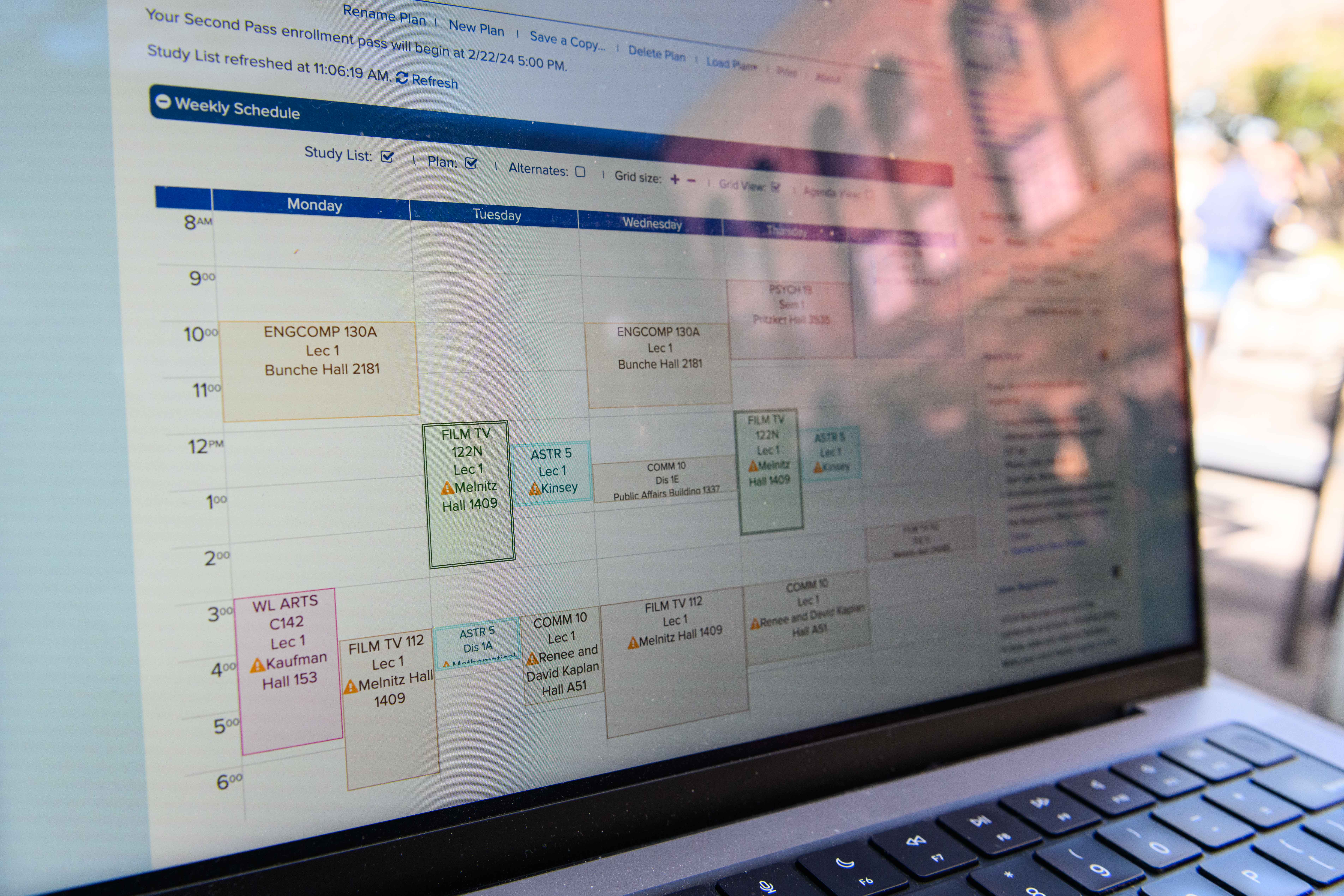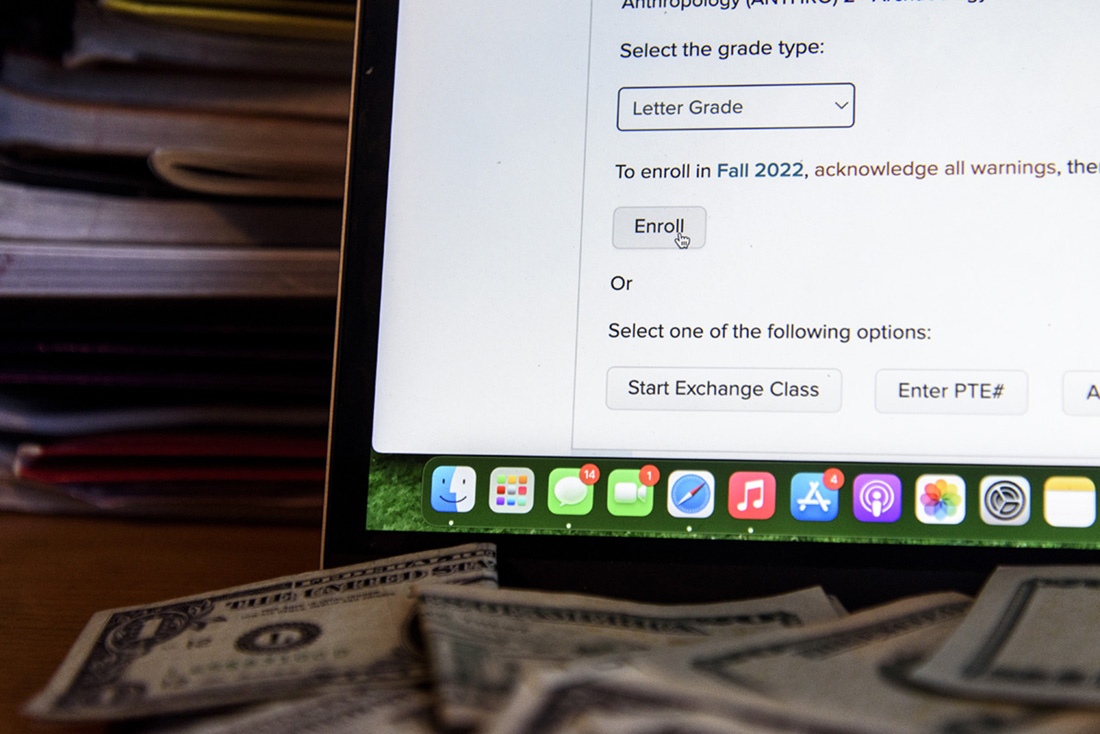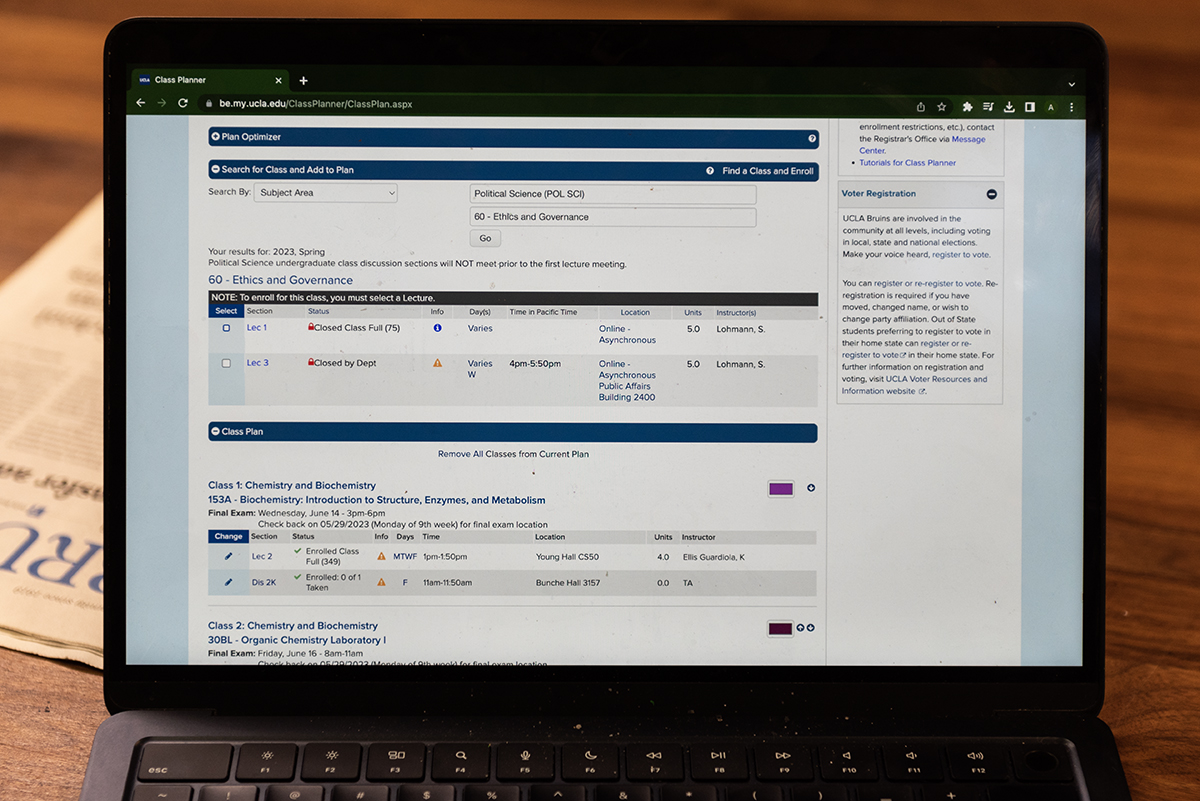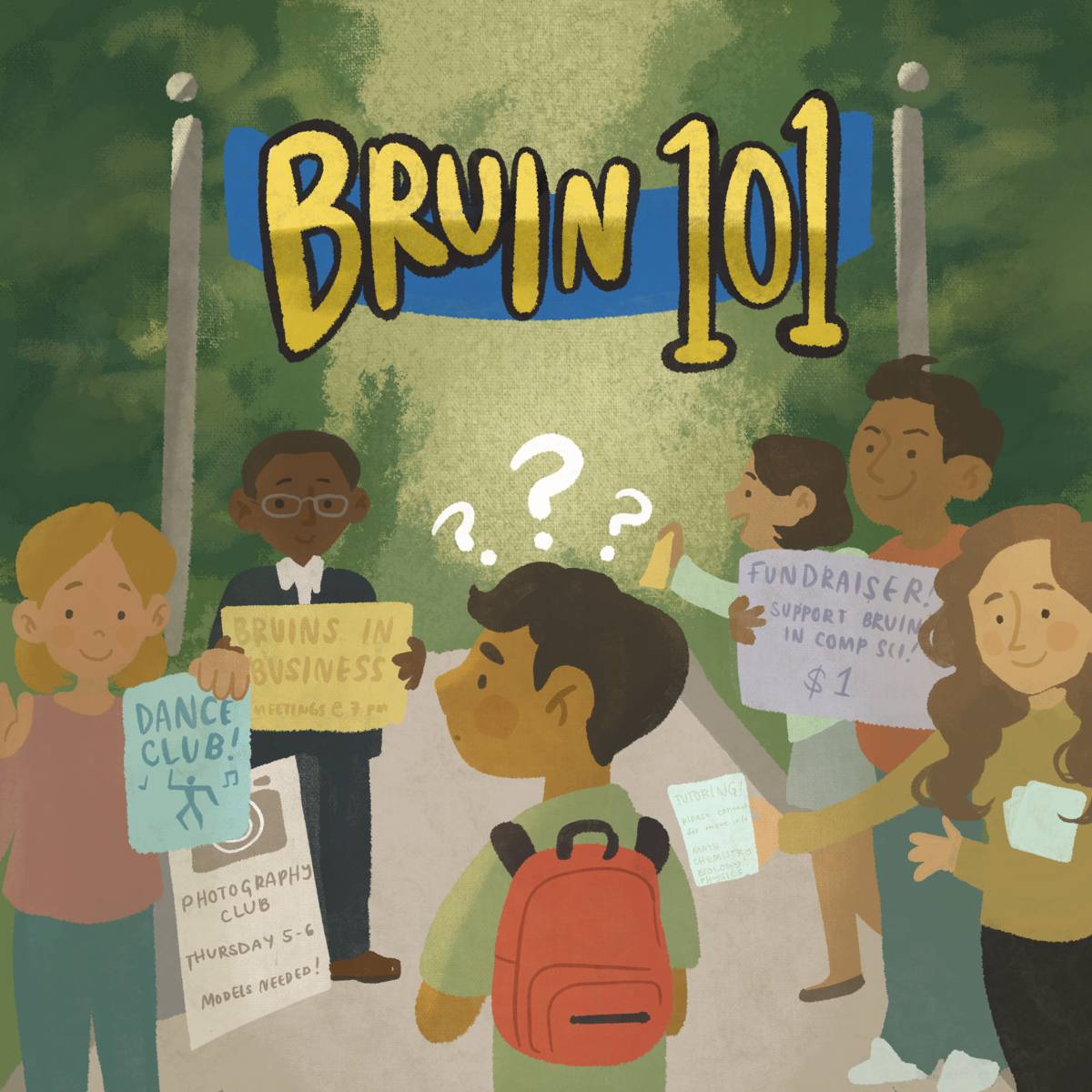How do enrollment times work, and how do they impact Bruins’ class choices?

Pictured is the MyUCLA class planner. Students use the class planner to organize their upcoming schedule and often explore several options to prepare for the possibility of classes filling before their enrollment times. (Jeremy Chen/Photo editor)
By Alicia Park
Feb. 22, 2024 8:54 p.m.
This post was updated Feb. 29 at 9:17 p.m.
Enrollment is a recurring college experience that allows Bruins to determine their academic experience by selecting courses and their corresponding professors every quarter.
According to the UCLA Registrar’s Office, enrollment for the academic year typically occurs about a month before the end of fall and winter quarters and a week after the end of spring quarter for the following quarters’ classes. Summer enrollment opens in February. The Registrar’s Office releases the official dates and times for enrollment passes and study lists with course offerings a few weeks before the actual enrollment appointment.
Students have the chance to plan their schedules on their class planner on MyUCLA before their enrollment appointment, allowing them time to select and arrange courses based on their graduation requirements, student reviews of professors on Bruinwalk and word-of-mouth reviews of certain classes. Miguel Luna, a third-year aerospace engineering student, said planning the ideal schedule may require multiple strategies.
“I think it’s best to always equip yourself with as many options as you can,” Luna said. “Things might not go your way most of the time, so it’s best to be prepared for that and have a few backups.”
While Bruins may strategize multiple plans for their upcoming enrollment, the ability to get their first plan of choice relies on their assigned enrollment pass.
Enrollment is split into priority, first and second passes, of which priority passes are earlier enrollment appointments for designated students. Most students will have a first and second pass to enroll in their desired classes, while priority group students have a priority, first and second pass to enroll.
All of the passes are spread across the span of two weeks, with the priority and first passes restricting students to enrolling in a combined 10 units, while the second pass allows students to enroll in as many additional units as allowed by their College or school study-list limit, according to the Registrar’s Office. Within each enrollment pass, students are further split into eight enrollment groups, which are spaced out within a few days of each other, according to the same source.
Enrollment groups are determined by units completed, which designate a student’s class standing. For example, students of senior standing with 135-plus units completed and readmitted students will go within the first few days. Meanwhile, students of junior standing with 90 to 134.9 units, sophomore standing with 45 to 89.9 units and freshman standing with 0 to 44.9 units are allotted to each following day in sequential order, according to the Registrar’s Office.
In an emailed statement, the UCLA Registrar’s Office said within specific enrollment groups, students are randomly assigned to different 30-minute periods based on units completed and priority status.
Chan Park, a first-year mathematics student, said he noticed the random assignment of appointment times within the enrollment groups.
“Sometimes it comes down to luck. I know a lot of people who are sophomore standing, but they’re (their enrollment time periods are) all sporadic,” Park said. “Some people have more (units) than others, but the people who have less are earlier than them for some reason during their time frame.”
According to the Registrar’s Office, the appointments are spaced out to allow each group to access the enrollment system. The Registrar’s Office assigns a series of 30-minute appointments to each group and gives out these appointments in accordance with the number of students within that group to maintain continuity in MyUCLA’s enrollment system.
While specific assigned appointment times are not under students’ control, the number of units completed is a predictable factor that can guarantee students’ ability to enroll on certain days.
Edward Liu, a New Student Advisor who advised freshmen through their first enrollment periods this summer, said he often needed to clarify to freshmen what units counted toward enrollment.
“Students sometimes come in with a lot of AP coursework, test work, and they think that because of that, they’re going to have a super fast enrollment time,” said Liu, a second-year electrical engineering student. “But the reality is, that only applies to community college direct coursework.”
Enrollment units only include transferable community college coursework and units completed at UCLA, making enrollment for those without such advantages and in popular majors difficult to navigate. Au Vo, a third-year microbiology, immunology and molecular genetics student, said pre-medical students often face difficulties in completing required class series.
“We have to take (the) Physics 5 series, and (the) Physics 5 series is notorious for having very limited spots, and so many pre-med students need to take the 5 series,” Vo said.
While Vo is a Regents Scholar and is able to use his priority pass to enroll in certain classes a few days earlier than other students, he said he noticed many students in his major had to wait until their third or even fourth year to begin with the Physics 5 series, a lower-division prerequisite series.
Vo can utilize a priority pass that occurs a few days before the first pass because of his Regents Scholarship, a scholarship awarded to up to 75 incoming freshmen or transfers each year based on academic and extracurricular achievements, according to UCLA Financial Aid and Scholarships. Other groups who receive the priority pass include designated students with disabilities, veterans, homeless or foster youth and NCAA athletes, according to the Registrar’s Office.
“The Undergraduate Council states that the intention of priority enrollment is: to have in place a system for special cases where the absence of priority enrollment would either jeopardize the retention of the individual at UCLA or seriously undermine an essential program,” the UCLA Registrar’s Office said in the written statement.
While certain groups may have the advantages of a priority pass or enrolling earlier after having completed more units relative to their peers, the majority of Bruins will have to rely on luck and preparation to enroll in an adequate schedule, according to students. Liu said as a student in the electrical engineering major, which has abundant course requirements, he has had to submit enrollment consideration forms to fulfill his course requirements for graduation.
“Sometimes it’s very, very clear early on that there’s way too many people … that need a specific math class when there’s clearly not enough slots in that math class,” Liu said. “We have to (then) submit an enrollment consideration form, and … it takes a long process. … I had to go through a Google form for the administrator and he had to manually put students in the class.”
Options such as enrollment consideration forms may be valuable for students in competitive majors. While the Registrar’s Office said there are no planned changes to the enrollment pass system at this time, it said it is working on making petition processes more efficient and always welcomes student feedback.
For Bruins, including those with priority passes like Vo, more clarity and structure to this system may improve the overall enrollment experience.
“It’s a slippery slope because UCLA has so many students, and a lot of these classes, they have only so many limited spaces because professors and TAs can only handle so much volume,” Vo said. “(A way to) fix the system right now is if administration can be much more clear with enrollment passes and how they get assigned instead of randomizing and doing a lottery system.”





